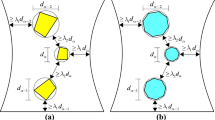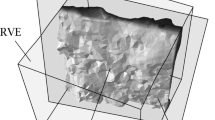Abstract
A recently developed FE-based mesostructural model for the mechanical behavior of heterogeneous quasi-brittle materials is used systematically to analyze concrete specimens in 2D. The numerical model is based on the use of zero-thickness interface elements equipped with a normal-shear traction-separation constitutive law representing non-linear fracture, which may be considered a mixed-mode generalization of Hillerborg’s “Fictitious Crack Model.” Specimens with 4 × 4 and 6 × 6 arrays of aggregates are discretized into finite elements. Interface elements are inserted along the main lines in the mesh, representing potential crack lines. The calculations presented in this paper consist of uniaxial tension loading, and the continuum elements themselves are assumed to behave as linear elastic. In this way, the influence of various aspects of the heterogeneous geometry and interface parameters on the overall specimen response has been investigated. These aspects are aggregate volume fraction, type of arrangement and geometry, interface layout, and values of the crack model parameters chosen for both the aggregate-aggregate and matrix-aggregate interfaces. The results show a good qualitative agreement with experimental observations and illustrate the capabilities of the model. In the companion second part of the paper, the model is used to represent other loading states such as uniaxial compression, Brazilian test, or biaxial loading.




















Similar content being viewed by others
References
Roelfstra PE, Sadouki H, Wittmann FH (1985) Le beton numerique. Mater Struct 18:309–317
Stankowski T (1990) Numerical simulation of progressive failure in particle composites. Doctoral Thesis, Dept. CEAE, University of Colorado, Boulder, CO 80309-0428, USA
Vonk R (1992) Softening of concrete loaded in compression. Ph.D. thesis, Technische Universiteit Eindhoven, Postbus 513, 5600 MB Eindhoven, The Netherlands
Wang J, Huet C (1993) A numerical model for studying the influences of pre-existing microcracks and granular character on the fracture of concrete materials and structures. In: Huet C (ed) Micromechanics of concrete and cementitious composites. Presses Politechniques et Universitaires Romandes, Lausanne, Switzerland, p 229
Schlangen E, van Mier J (1992) Micromechanical analysis of fracture of concrete. Int J Damage Mech 1:435
Schlangen E (1993) Experimental and numerical analysis of fracture processes in concrete. Ph.D. thesis, T. U. Delft, The Netherlands
Schlangen E, Garboczi E (1996) New method for simulating fracture using an elastically uniform random geometry lattice. Int J Eng Sci 34:1131
Zubelewicz A, Bažant ZP (1987) Interface element modeling of fracture in aggregate composites. ASCE J Eng Mech 113:1619–1630
Bažant ZP, Tabbara M, Kazemi M, Pijaudier-Cabot G (1990) Random particle model for fracture or fiber composites. ASCE J Eng Mech 116:1686–1705
Jirásek M, Bažant ZP (1995) Particle model for fracture and statistical micro-macro correlation of material constants. In: Wittman F (ed) Fracture mechanics of concrete structures (FraMCoS 2). Aedificatio Publishers, Freiburg, Zurich, Switzerland
Bolander JE, Saito S (1998) Fracture analysis using spring networks with random geometry. Eng Fract Mech 61(5/6):569–591
Bolander JE, Hong GS, Yoshitake K (2000) Structural concrete analysis using rigid-body-spring networks. J Comp Aided Civil Infrastruct Eng 15:120–133
Cusatis G, Bažant ZP, Cedolin L (2003) Confinement-shear lattice model for concrete damage in tension and compression: I. Theory. ASCE J Eng Mech 129(12):1439–1448
Cusatis G, Bažant ZP, Cedolin L (2003) Confinement-shear lattice model for concrete damage in tension and compression: II. Computation and validation. ASCE J Eng Mech 129(12):1449–1458
Hillerborg A, Modéer M, Petersson PE (1976) Analysis of crack formation and crack growth in concrete by means of fracture mechanics and finite elements. Cement Concrete Res 6(6):773–781
Rots JG (1988) Computational modelling of concrete fracture. Ph.D. thesis, Delft University of Technology, Delft, The Netherlands
Camacho GT, Ortiz M (1996) Computational modelling of impact damage in brittle materials. Int J Solids Struct 33(20–22):2899–2938
Carol I, López CM (1999) Failure analysis of quasi-brittle materials using interface elements. In: Pijaudier-Cabot G, Bittnar Z, Gérard B (eds) Mechanics of quasi-brittle materials and structures, Hermes Science Publications, 75004 Paris, pp 289–305
Gens A, Carol I, Alonso E (1988) An interface element formulation for the analysis of soil-reinforcement interaction. Comput Geotechnics 7:133–151
Rots JG, Schellekens JCJ (1990) Interface elements in concrete mechanics. In: Bicanic N, Mang H (eds) Computer aided analysis and design of concrete structures (SCI-C). Pineridge {P} press, Swansea, pp 909–918
López CM (1999) Microstructural analysis of concrete fracture using interface elements. Application to various concretes (In Spanish). Doctoral Thesis. Universitat Politecnica de Catalunya. ETSECCCP-UPC, E-08034 Barcelona, Spain
López CM, Carol I, Aguado A (2000) Microstructural analysis of concrete fracture using interface elements. In: Oñate E et al (eds) European congress on computational methods in applied sciences and engineering-ECCOMAS 2000. CIMNE, Barcelona, Spain (in CD ROM)
Carol I, López CM, Roa O (2001) Micromechanical analysis of quasi-brittle materials using fracture-based interface elements. Int J Numer Methods Eng 52:193–215
Caballero A (2005) 3D meso-mechanical numerical analysis of concrete using interface elements. Ph.D. thesis, ETSECCPB-UPC, E-08034 Barcelona, Spain
Caballero A, López CM, Carol I (2006) 3D meso-structural analysis of concrete specimens under uniaxial tension. Comput Methods Appl Mech Eng 195(52):7182–7195
Caballero A, Carol I, López CM (2006) A meso-level approach to the 3D numerical analysis of cracking and fracture of concrete materials. Fatigue Fract Eng Mater Struct 29:979–991
Carol I, Prat PC (1990) A statically constrained microplane for the smeared analysis of concrete cracking. In: Bicanic N, Mang H (eds) Computer aided analysis and design of concrete structures, Pineridge Press, Swansea, pp 919–930
Carol I, Prat PC (1995) A multicrack model based on the theory of multisurface plasticity and two fracture energies. In: Owen DRJ, Oñate E, Hinton E (eds) Computational plasticity (COMPLAS IV). Pineridge Press, Barcelona, pp 1583–1594
Carol I, Prat PC, López CM (1997) A normal/shear cracking model. Application to discrete crack analysis. J Eng Mech 123(8):765–773
Hassanzadeh M (1990) Determination of fracture zone properties in mixed mode I and II. Eng Fract Mech 35(4/5):845–853
Prat P, Gens A, Carol I, Ledesma A, Gili J (1993) DRAC: a computer software for the analysis of rock mechanics problems. In: Liu H (ed) Application of computer methods in rock mechanics, 2, Shaanxi Science and Technology Press, Xian, China, pp 1361–1368
Marques J (1984) Stress computation in elastoplasticity. Eng Comput 1:42–51
Crisfield M (1991) Non-linear finite element analysis of solids and structures, vol 1. Wiley, New York, EEUU
Hordijk DA (1992) Tensile and tensile fatigue behaviour of concrete; experiments, modeling and analyses. HERON, vol 37. Stevin Laboratory and TNO Research, Delft, The Netherlands
Petersson PE (1981) Crack growth and development of fracture zones in plain concrete and similar materials. Report TVBM-1006, Division of Building Materials, Lund Institute of Technology, Lund, Suecia
Wolinski S, Hordijk DA, Reinhardt HW, Cornelissen HAW (1987) Influence of aggregate size on fracture mechanics parameters of concrete. Int J Cement Comp Lightweight Concrete 9(2):95–103
Wittmann FH, Rokugo K, Brühwiler E, Mihashi H, Simonin P (1988) Fracture energy and strain softening of concrete as determined by means of compact tension specimens. Mater Struct Matériaux et Constructions 21:21–32
Hordijk DA (1991) Local approach to fatigue of concrete. Ph.D. thesis, Delft University of Technology, Delft, The Netherlands
van Mier JGM (1997) Fracture processes of concrete. CRC Press, Boca Raton
Nomura N, Mihashi H, Izumi M (1991) Properties of fracture process zone and tension softening behaviour of concrete. In: van Mier JGM, Rots JG, Bakker A (eds) Fracture processes in concrete, rock and ceramics. Chapman & Hall/E&FN Spon, London/New York, p 51
Feng N, Ji X, Zhuang Q, Ding J (1995) Effect of concrete materials on fracture performance. In: Wittmann FH (ed) Fracture mechanics of concrete structures. Proceedings of the FRAMCOS-2, Aedificatio Publishers, D-79104, Freiburg, pp 119–124
Bažant ZP, Oh B (1983) Microplane model for fracture analysis of concrete structures. In: U.S. Air Force Academy (ed) Proceedings of the symposium on the interaction of non-nuclear munitions with structures, Colorado Springs, pp 49–55
Acknowledgements
This research has been supported by grants MAT2003-02481 and BIA2006-12717 funded by MEC (Madrid), and 80015/A04 funded by MFOM (Madrid). The first author also wishes to thank MEC for the “Ramon y Cajal” research position received during the period 2001–2006.
Author information
Authors and Affiliations
Corresponding author
Rights and permissions
About this article
Cite this article
López, C.M., Carol, I. & Aguado, A. Meso-structural study of concrete fracture using interface elements. I: numerical model and tensile behavior. Mater Struct 41, 583–599 (2008). https://doi.org/10.1617/s11527-007-9314-1
Received:
Accepted:
Published:
Issue Date:
DOI: https://doi.org/10.1617/s11527-007-9314-1




